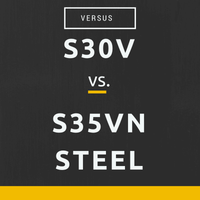S30V vs. S35VN Steel: Differences and Advantages of Each

By Larry Connelley
When looking at quality American-made knives, you'll notice that S35VN and S30V steel are two of the more popular steels for knife blades. Both S30V and S35VN steel are made with the same carbon and chrome content, and from various tests, both steels provide the same edge retention and corrosion resistance. While they have similar histories and composition, there are a few key differences that could affect performance for certain users.
CPM American Steels
Both S35VN and S30V steels were developed in a collaboration between Chris Reeve and Crucible Industries, a New York-based steel manufacturer, using Crucible Particle Metal (CPM) technology. CPM technology helps to make homogeneous steel by distributing carbides in the blade evenly. Carbides are the hard particles in steel that allow the blade to keep an edge. This high-end steel foundry process leads to superior stability, toughness and grind-ability with a cleaner finish than traditionally made steel. Particle metal steel manufacturing is only done by a handful of steel manufacturers around the world.
What is remarkable about the steels is that both were developed for the knife industry! Many of the other previous Crucible Particle Metal (CPM) steels were developed for the plastics manufacturing industry and other advanced manufacturing industries.
S30V and S35VN are each classified as a premium steel, as they offer an excellent combination of quality and affordability. Depending on the heat-treatment of the knife, you can expect knives made with one of these steels to have a Rockwell Hardness between 58 and 61. This makes each type a great steel for everyday use, especially in tough environments. The difference between the two is in the details.
S30V Steel
Introduced in 2001, S30 steel is made with 1.45% carbon, 4% vanadium, and 10.5% chromium carbide. This steel continues to be one of the best knife steels on the market for a wide range of knife uses and applications. Vanadium carbides are some of the most prized carbides for knives. Their carbides provide extreme hardness in the steel alloy matrix. This helps hard-use blades such as an S30V bowie knife retain their edge and resist corrosion. S30V is generally regarded as one of the best-value fine knife steels in the industry.
S35VN Steel
S35VN, first created in 2009, modified the formula of S30V by adding niobium to the vanadium and chromium carbide forming elements. The addition of niobium reflects the addition of N in the name of the steel. The specific formula for S35VN knife steel - aka the "ultimate mainstream steel" - is 3% vanadium, 1.4% carbon, 0.5% niobium, 2% molybdenum, and 10.5% chromium. This composition makes it tougher (resistance to edge chipping) without reducing the wear resistance (edge holding) of the steel. S35VN also has a finer grain structure than S30V. Yet it is easier to machine, grind and polish due to the substitution of niobium for a part of vanadium plus the addition of molybdenum. Because of these manufacturing features, knifemakers might choose to use S35VN rather than S30V from a process perspective and/or for an extreme-use fixed blade for slightly increased toughness.
Conclusion
A knife with a blade made with either S35VN or S30V is using a high-quality blade steel. Both are able to withstand long-term use. Even with their slight, technical differences, most knife-users will not likely notice any changes in performance between these two high-quality steels. However, extreme outdoorsmen and tactical users will feel more confident with an S35VN steel knife blade.
Value Added Article Produced by KnifeArt.com. If you enjoyed this article and it helps in your knife search, we would love to have you as our customer. Links and social media shares are also appreciated.
